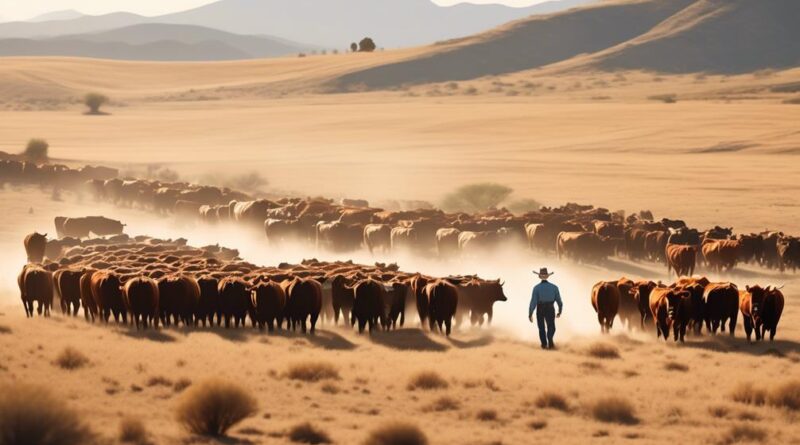5 Easy Techniques for Stress-Free Cattle Handling
Imagine cattle handling as a delicate dance, where your movements and demeanor dictate the rhythm of the interaction. When it comes to managing livestock, mastering the art of stress-free handling is akin to conducting a symphony – every gesture matters.
You might be surprised to learn that a few simple adjustments to your approach can transform the way you handle cattle, leading to calmer, more cooperative animals and a smoother workflow.
But how exactly can you achieve this harmony in your handling techniques?
Proper Stockmanship
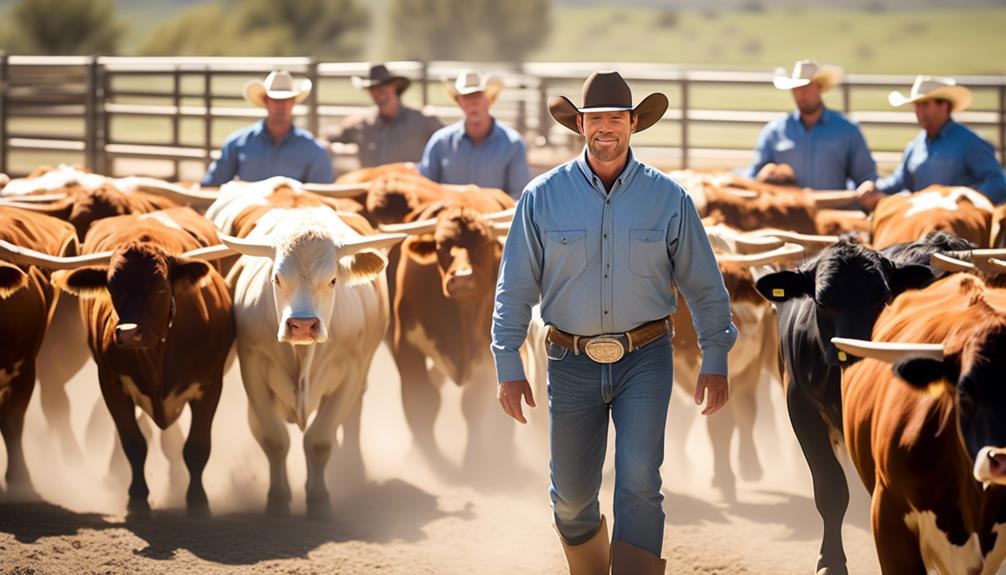
When handling cattle, it's essential to develop a deep understanding of their behavior and needs to ensure proper stockmanship. By understanding animal behavior, you can employ effective handling techniques that minimize stress on the cattle. One key aspect of proper stockmanship is the use of low-stress handling methods. This involves working with the natural instincts of the cattle to guide them in the desired direction rather than using forceful methods that can cause distress.
Understanding animal behavior is crucial when implementing handling techniques. Cattle have a strong herd instinct, and their behavior is influenced by factors such as their environment, social structure, and past experiences. By recognizing these behaviors, you can predict how the cattle will react in different situations and adjust your handling techniques accordingly. For example, knowing that cattle tend to move away from pressure allows you to use this instinct to calmly direct them where you need them to go.
Using proper stockmanship techniques not only reduces stress on the cattle but also makes handling them safer for the handlers. By moving and handling the cattle in a calm and controlled manner, you can minimize the risk of injuries to both the animals and the handlers. Additionally, employing low-stress handling techniques can lead to improved animal welfare and productivity, as stressed animals are more prone to health issues and reduced performance.
Therefore, developing a deep understanding of animal behavior and employing appropriate handling techniques is essential for ensuring stress-free cattle handling.
Quiet Handling
To ensure stress-free cattle handling, focus on implementing quiet handling techniques that promote a calm and controlled environment for the animals. By practicing gentle restraint and silent communication, you can create a peaceful atmosphere that reduces stress and encourages cooperative behavior in your cattle.
Here are four key techniques for quiet handling that will benefit both you and your animals:
- Gentle Restraint: Use low-stress cattle handling methods that involve gentle physical contact. Avoid excessive force or sudden movements that can startle the animals. By calmly and gently guiding the cattle, you can minimize their anxiety and build trust.
- Silent Communication: Communicate with your cattle using quiet, soothing tones and minimal physical cues. Avoid loud noises, shouting, or aggressive gestures that can agitate the animals. By maintaining a calm and composed presence, you can reassure the cattle and establish a sense of security.
- Slow Movements: Practice slow, deliberate movements when interacting with your cattle. Avoid sudden or erratic actions that can cause fear or confusion. By moving at a relaxed pace, you can convey a sense of tranquility and stability to the animals.
- Patience and Observation: Take the time to observe and understand the behavior of your cattle. Be patient and attentive, allowing the animals to acclimate to your presence and movements. By demonstrating patience and empathy, you can foster a harmonious relationship with your cattle.
Effective Sorting
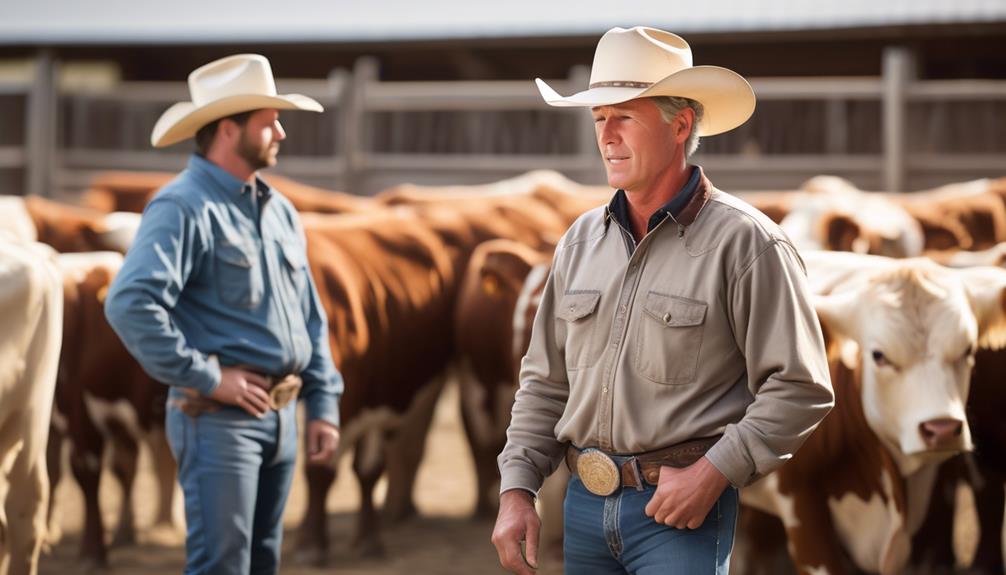
Implement a systematic and organized approach to sorting cattle to streamline the process and minimize stress for both the animals and handlers. Efficient sorting techniques are essential for stress-free livestock separation.
Start by ensuring that the sorting area is well-designed and equipped with proper handling facilities. Use curved alleys and open-sided pens to encourage cattle to move calmly through the sorting process. Keep the area well-lit to reduce shadows that may startle the animals.
When sorting, move the cattle in small, manageable groups. This allows for better control and reduces the likelihood of animals becoming agitated. Utilize flags or paddles to guide the cattle rather than relying on loud noises or excessive prodding. By calmly directing the animals, you can minimize stress and prevent them from becoming anxious or resistant.
To ensure efficient sorting, it's important to have well-trained personnel. Handlers should be familiar with the cattle and understand how to use their body language to influence the animals' movements. Avoid sudden movements and loud voices, as these can lead to heightened stress levels in the cattle.
Additionally, using low-stress livestock handling methods, such as the Bud Box or the T-System, can greatly aid in efficient and stress-free sorting.
Low-Stress Herding
Ensure a seamless continuation from effective sorting procedures by integrating low-stress herding techniques into your cattle handling practices. Low-stress herding is essential for maintaining the calmness of your cattle and ensuring efficient movement throughout your operations.
Here are four key techniques to help you achieve smooth transitions and reduce stress in your herd:
- Establish Clear Pathways: Designate clear pathways for herding your cattle to minimize confusion and anxiety. Clear, well-defined routes will help guide the cattle smoothly, reducing the likelihood of them becoming agitated or hesitant.
- Use Gentle Pressure: Apply gentle, consistent pressure to encourage the natural movement of the cattle. Avoid sudden movements or loud noises, as these can startle the animals and lead to unnecessary stress.
- Utilize Natural Instincts: Understand the natural instincts of cattle and use them to your advantage. By working with their instincts, such as their tendency to move away from pressure, you can guide them in the desired direction with minimal resistance.
- Maintain Visual Contact: When herding your cattle, maintain visual contact with the animals to reassure them and prevent any potential panic. Be observant of their body language and adjust your movements accordingly to ensure a steady and relaxed herding process.
Gentle Loading and Unloading
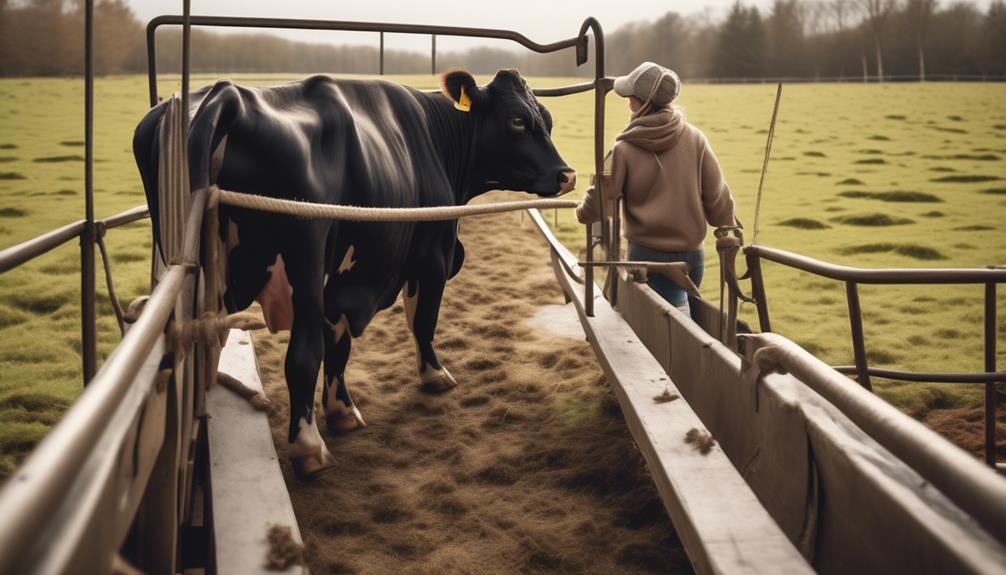
When loading and unloading your cattle, focus on maintaining a calm and steady environment to minimize stress and ensure smooth transitions. Trailer training is an essential aspect of gentle loading and unloading.
Start by familiarizing your cattle with the trailer in a non-threatening way. Allow them to explore the trailer at their own pace, making it a positive experience by providing treats or feed near the trailer. Gradually, introduce them to stepping onto the trailer, using gentle encouragement and rewards to reinforce positive behavior. This trailer training helps them become more comfortable with the loading process, reducing anxiety and resistance.
Behavior modification is another effective technique for gentle loading and unloading. By understanding your cattle's behavior, you can address any specific concerns they may have about entering or exiting the trailer.
For instance, if a particular animal is hesitant, you can use desensitization methods to gradually acclimate them to the trailer. This might involve starting with simple tasks, such as walking near the trailer, and then progressing to short periods of standing inside it. By breaking down the process into manageable steps and rewarding desired behaviors, you can help your cattle overcome their apprehensions.
Calm Handling in Chutes
To keep cattle calm in chutes, gently guide them using slow, deliberate movements and avoid sudden noises or movements that could startle them. When handling cattle in chutes, remember that a calm environment is key to reducing stress and improving overall handling.
Here are some techniques to help you handle cattle in chutes with ease:
- Chute Maintenance: Ensure that the chutes are well-maintained to prevent any sudden noises or movements that could startle the cattle. Regularly inspect the chutes for any loose parts or potential hazards that could cause unnecessary stress to the animals.
- Safety Precautions: Prioritize safety measures to create a secure environment for both the cattle and the handlers. By implementing safety protocols and equipment, you can reduce the risk of accidents and reassure the cattle that they're in a safe space.
- Positive Reinforcement: Utilize positive reinforcement techniques to encourage calm behavior in the chutes. Rewarding the cattle for calm and cooperative behavior can help create a positive association with the handling process.
- Behavior Training: Invest time in behavior training to familiarize the cattle with the chute environment. Gradual exposure and training can help the cattle become more comfortable and less anxious when being handled in the chutes.
Minimized Disturbance in Facilities
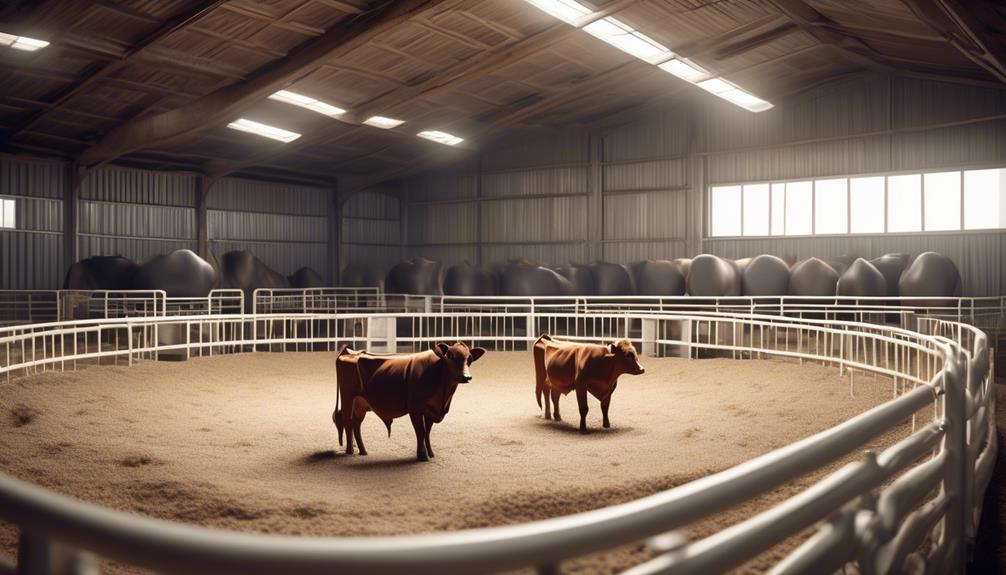
Maintain a calm and controlled environment in cattle handling facilities to minimize disturbances and reduce stress on the animals. By doing so, you can ensure improved handling and reduced anxiety for your cattle.
One effective way to minimize disturbance in facilities is to design the layout with animal behavior in mind. Ensure that the flow of cattle through the facility is smooth, with minimal stops and starts, to prevent unnecessary stress. Additionally, consider using solid panels instead of bars in the chute to reduce visual distractions and keep the animals focused on moving forward.
Another crucial aspect of minimizing disturbance in facilities is to maintain a quiet environment. Loud noises can startle cattle and increase their anxiety levels. Implement sound-absorbing materials in the facility and encourage handlers to communicate calmly and quietly. Avoid sudden movements and loud equipment whenever possible.
Furthermore, controlling the lighting in the facility can significantly impact the animals' stress levels. Use natural lighting whenever feasible, as it has a calming effect on cattle. When artificial lighting is necessary, opt for soft, diffused lighting to create a more relaxed atmosphere.
Lastly, keep the facility clean and well-maintained. Cattle are sensitive to their surroundings, and a dirty or cluttered environment can contribute to their stress. Regularly inspect and maintain the facility to ensure that it remains a calm and controlled space for the animals.
Respectful Animal Movement
Create a calm and gentle atmosphere to facilitate the respectful movement of cattle through handling facilities, minimizing stress and promoting efficient handling. When handling cattle, it's crucial to understand their behavior and communicate with them effectively. Here are some key points to consider:
- Understanding animal behavior: Recognizing the natural instincts and behavior patterns of cattle can help you anticipate their movements and react accordingly. By understanding their flight zone and point of balance, you can guide them through handling facilities with minimal stress.
- Use communication cues: Cattle respond to visual and auditory cues, so it's important to use body language and voice commands to direct their movement. Gentle gestures and calm vocal tones can help reassure the animals and encourage them to move in the desired direction.
- Minimize distractions: Creating a quiet and low-stress environment can significantly reduce the likelihood of cattle becoming agitated or uncooperative. Limiting sudden noises and movements, as well as maintaining a consistent handling routine, can contribute to respectful animal movement.
- Provide adequate space: Ensuring that handling facilities have sufficient space for cattle to move comfortably can prevent overcrowding and potential conflicts among the animals. Ample space allows them to move freely, reducing anxiety and facilitating respectful movement.
Frequently Asked Questions
What Are Some Common Mistakes That Can Make Cattle Handling More Stressful for the Animals?
When handling cattle, common mistakes include improper handling techniques that can stress the animals. Utilize calming methods such as gentle movements and low-stress handling to ensure a stress-free environment for the cattle.
How Can Weather Conditions Impact the Stress Levels of Cattle During Handling?
Weather conditions can impact cattle stress levels. High temperatures and humidity can increase stress, while wind and precipitation can also affect handling stress. It's important to consider these factors when working with cattle to ensure their well-being.
Are There Specific Techniques for Calming Down Individual Cattle That May Be More Anxious or Agitated?
To calm down individual cattle that may be anxious or agitated, use calming signals and pay attention to their behavioral cues. This approach helps reduce stress and creates a more comfortable environment for the cattle.
What Role Does Body Language and Positioning Play in Effective Low-Stress Herding?
Body language and positioning are crucial in effective herding. Your non-verbal cues can communicate calmness and reduce stress for the cattle. By using low-stress handling techniques, you can guide the herd with ease and minimal anxiety.
How Can Handlers Ensure That Cattle Are Not Overcrowded or Pushed Too Quickly Through Chutes and Facilities During Handling?
To ensure cattle aren't overcrowded or pushed too quickly, focus on proper chute design. Use slow, steady movements and avoid rushing. This reduces stress and promotes smooth handling, benefiting both the animals and handlers.
Conclusion
In conclusion, by implementing the techniques of proper stockmanship, quiet handling, effective sorting, low-stress herding, and gentle loading and unloading, you can ensure stress-free cattle handling.
Remember to always handle the animals calmly in chutes, minimize disturbance in facilities, and respect their movement.
By incorporating these easy techniques, you can create a more efficient and peaceful environment for both yourself and the cattle.
